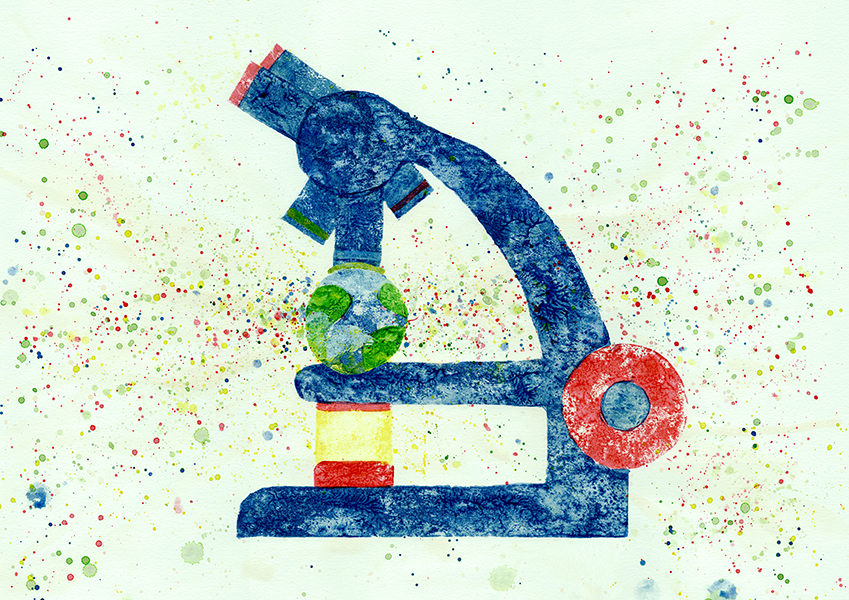Glyphosate is a common herbicide used in low-tillage farming. However, despite its popularity, it doesn’t come without risks. If it remains in the soil too long, it can harm beneficial microbes and degrade soil health over time. Until recently, the two microbial pathways known to degrade glyphosate were simply metabolic pathways that had been inefficiently repurposed to degrade this synthetic compound. Scientists Geoff P. Horsman and Adrian Van Dyk have now discovered a new enzyme that appears to degrade glyphosate more efficiently, opening doors for better soil health management. The duo discussed this discovery during our recent episode of Microbes and Us, along with their reactions to winning the FEMS Article Award in FEMS Microbiology Letters for their paper.
Glyphosate: A Double-Edged Sword
Glyphosate is a synthetic compound used in many herbicide formulations. Now off-patent, it is commonly used in low- or no-tillage farming (where soil isn’t ploughed to avoid disturbing the ecosystem). This method helps reduce soil erosion, lower equipment and fuel costs, and preserve soil structure. Glyphosate is considered one of the safer herbicides because it targets a very specific biological pathway (the aromatic amino acid pathway) which exists only in plants, fungi, and microbes. This pathway is essential for producing key compounds like lignin in plants; disrupting it causes plant death.
However, glyphosate still poses risks. If left in the soil too long, it might reduce seed germination and growth. It can also harm the soil microbiome by killing beneficial microbes. This disrupts the balance of microorganisms that maintain healthy soil, potentially reducing plant growth and crop yields over time. There have been two known microbial degradation routes:
- Carbon-Phosphorus Lyase (C–P Lyase) Pathway
- Glycine Oxidase-Mediated Degradation (an indirect route producing AMPA)
Glyphosate contains a strong carbon-phosphorus bond, which is hard to break. The C–P Lyase pathway breaks this bond to release phosphorus, but it is too slow to confer glyphosate resistance. If glyphosate kills the organism before this pathway can act, it’s ineffective. The scientists note that they have never seen this pathway provide resistance in natural settings. The Glycine Oxidase pathway converts glyphosate into aminomethylphosphonic acid or AMPA, which is then broken down via the C–P Lyase system. However, most natural glycine oxidases strongly prefer glycine over glyphosate, making them inefficient at breaking down glyphosate. So until now, no glyphosate-specific oxidase had been identified.
That changed with Horsman and Van Dyk’s research.
The Discovery
Horsman and Van Dyk discovered the first known glyphosate oxidase, an enzyme that specifically degrades glyphosate. This enzyme helps bacteria not only survive glyphosate exposure but also use it as a source of phosphorus.
It was found in bacteria from glyphosate-exposed environments, suggesting a natural adaptation. The enzyme likely evolved from a pre-existing glycine oxidase that now shows greater preference for glyphosate. Like the indirect pathway, this enzyme also converts glyphosate into AMPA. But because it strongly favors glyphosate, it’s more efficient and protective, allowing microbes to resist glyphosate and make use of it.
How They Got Here
The discovery came via functional metagenomics, using DNA extracted from soil in a Canadian wheat field. Soil bacteria from glyphosate-exposed environments were more likely to express the enzyme. The researchers inserted environmental DNA into cosmid vectors and introduced these into E. coli, which is normally sensitive to glyphosate. The modified E. coli were then grown in media where glyphosate was the only phosphorus source. Only the cells that acquired the ability to degrade glyphosate through the inserted DNA survived. The researchers analyzed these colonies and identified the new glyphosate oxidase gene. Extreme care was taken to avoid phosphorus contamination by ensuring only dedicated chemicals and ultrapure water were used were used. This rigorous process confirmed that the enzyme allowed the E. coli to neutralize glyphosate and grow using it as a phosphorus source, something wild-type E. coli cannot do.
This discovery highlights the astonishing capacity of microbes to adapt to man-made chemicals in the environment.
What’s Next?
This finding enhances our understanding of how glyphosate breaks down in the soil and could guide better bioremediation and soil health strategies. And as good research would have it, it opens up avenues for further exploration triggering questions like how does this enzyme fit into our broader understanding of glyphosate’s impact on soil microbiomes? Can this enzyme be used to help engineer microbes or design bioremediation tools for glyphosate-polluted environments? Are there other bacteria with similar glyphosate oxidase enzymes waiting to be discovered? Can structural models (e.g., AlphaFold) help explain why this enzyme prefers glyphosate over glycine? Can we trace its evolutionary history—did it arise only after glyphosate use became common, or was it already present in some microbes?
While many questions remain to be answered, one thing is for sure:, the discovery of this enzyme is already a big step forward to solving a number of challenges in maintaining soil health after prolonged herbicide use.
Listen to the full Microbes and Us episode here: Episode 32: Article Award Winners in FEMS Microbiology Letters: Discovery if a glyphosate oxidase in nature.
Interested in microbiology: Subscribe to our podcast, Microbes and Us on Spotify.
